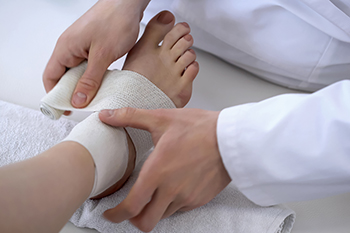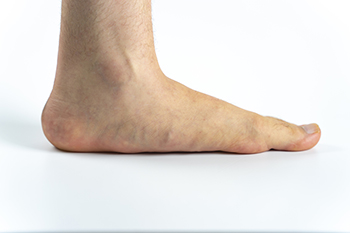
Cedarhurst (516) 374-3668
Franklin Square (516) 775-8440

Cedarhurst (516) 374-3668
Franklin Square (516) 775-8440

The words sprain and strain are very similar. So too, are several symptoms of an ankle sprain and ankle strain. Ankle sprains involve the ligaments which hold the bones of the ankle together and support it, while strains involve ankle muscles, often where the muscle attaches to a tendon. In a sprain, the pain is immediate and there may be bruising, while pain from a strain can sometimes come on gradually and a bruise is typically not visible. Both injuries can produce localized swelling, inflammation, and redness. Yet, there may be a noise—an audible popping sound the moment the ligament is injured—in an ankle sprain, which does not occur when you strain the muscles in your ankle. However, you may experience cramps, spasms, or weakness in the muscle when you’ve strained your ankle, which usually doesn’t occur if you’ve sprained the ligaments of your ankle. Both conditions can make it difficult or impossible to move your ankle or to place weight on it. If you are experiencing any type of pain, inflammation, redness, or swelling in your ankles, contact a podiatrist to have your condition properly diagnosed and treated.
Although ankle sprains are common, they aren’t always minor injuries. If you need your ankle injury looked at, contact Robert Stein, DPM from South Shore Foot Care. Our doctor can provide the care you need to keep you pain-free and on your feet.
How Does an Ankle Sprain Occur?
Ankle sprains are the result of a tear in the ligaments within the ankle. These injuries may happen when you make a rapid shifting movement while your foot is planted. A less common way to sprain your ankle is when your ankle rolls inward while your foot turns outward.
What Are the Symptoms?
Preventing a Sprain
Treatment of a Sprain
In many cases, the RICE method (Rest, Ice, Compression, and Elevate) is used to treat ankle sprains. However, you should see a podiatrist to see which treatment option would work best with your injury. In severe cases, surgery may be required.
It is important to ask your doctor about rehab options after you receive treatment for your injury. Stretching, strength training, and balance exercises may help the ankle heal while also preventing further injury.
If you have any questions, please feel free to contact our offices located in Cedarhurst and Franklin Square, NY . We offer the newest diagnostic and treatment technologies for all your foot care needs.
Swollen legs, ankles and feet are common for most women when they are expecting a baby. A buildup of fluid, an increase in weight, hot weather, gravity, and standing for long periods are contributing factors. Swelling (edema) during pregnancy usually gets worse in the last trimester and right after birth. One way to avoid some of the swelling is by eating healthy foods, including fish, lean meats, poultry and lots of fresh fruit and vegetables. In addition, try to reduce the amount of salt, fats and sugar, and especially processed foods, that you consume. Plus, it’s a good idea to drink plenty of water to flush the system. Try to stay off your feet and keep them elevated, particularly later in the day. Do ankle rolls and foot flexes to increase blood flow to the feet. If swelling becomes severe and moves up the calf, or if pressing on your ankle or leg leaves an indentation, it may be a sign of something more serious. It is suggested that you see a podiatrist immediately who can examine the feet and ankles properly and recommend treatment options.
Pregnant women with swollen feet can be treated with a variety of different methods that are readily available. For more information about other cures for swollen feet during pregnancy, consult with Robert Stein, DPM from South Shore Foot Care. Our doctor will attend to all of your foot and ankle needs.
What Foot Problems Can Arise During Pregnancy?
One problem that can occur is overpronation, which occurs when the arch of the foot flattens and tends to roll inward. This can cause pain and discomfort in your heels while you’re walking or even just standing up, trying to support your baby.
Another problem is edema, or swelling in the extremities. This often affects the feet during pregnancy but tends to occur in the later stages.
How Can I Keep My Feet Healthy During Pregnancy?
If you have any questions please feel free to contact our offices located in Cedarhurst and Franklin Square, NY . We offer the newest diagnostic and treatment technologies for all your foot and ankle needs.
If you sometimes experience redness and burning in your feet, as well as other body parts, you may have a disorder known as erythromelalgia. Flare-ups, which can last for days, usually start out as itching, which then becomes burning pain, redness and mottled skin. Erythromelalgia can affect your ability to stand, exercise and sleep. Its symptoms may be triggered by an increase in body temperature after exercising, wearing warm socks, being dehydrated, or even eating spicy food. The cause for most people is unknown, but erythromelalgia has been linked to several underlying conditions, including peripheral neuropathy, rheumatoid arthritis and lupus. It also may be triggered by taking certain medications. Self-treatment is not recommended, as it may lead to more serious problems. Instead, if you think this condition is affecting your feet, as well as limiting your daily activities, it is wise to seek the counsel of a podiatrist for analysis and possible treatment options.
When dealing with systemic disease of the feet, it is extremely important to check the affected areas routinely so that any additional problems are caught quickly. If you have any concerns about your feet and ankles contact Robert Stein, DPM from South Shore Foot Care. Our doctor will assist you with all of your podiatric needs.
Systemic Diseases of the Feet
Systemic diseases affect the whole body, and symptoms usually are displayed in the feet. This condition can make a patient’s ability to walk unbearable. Systemic diseases include gout, diabetes mellitus, neurological disorders, and arthritis.
Gout – is caused by an excess of uric acid in the body. Common symptoms include pain, inflammation, and redness at the metatarsal/phalangeal joint of the base big toe. Gout can be treated by NSAIDs to relieve pain and inflammation, and other drugs that lower the acid levels in the body.
Diabetes mellitus – is an increase in the level of blood sugar that the body cannot counteract with its own insulin. Failure to produce enough insulin is a factor in Diabetes.
Diabetes of the Feet
Diabetic Neuropathy – may lead to damaged nerves and affect the feet through numbness and loss of sensation.
Peripheral Vascular Disease – can restrict the blood flow to the feet, and often times lead to amputation of the feet.
If you have any questions please feel free to contact our offices located in Cedarhurst and Franklin Square, NY . We offer the newest diagnostic and treatment technologies for all your foot and ankle needs.
 There are many people that are born with flat feet. This condition can be identified by standing on the floor and noting if the entire foot lies flat. Additionally, flat feet may be part of a genetic disorder, and there may be pain in the feet and ankles that are associated with it. Research has shown there are two types of flat feet. Rigid flat feet indicate the arch is completely missing, and flexible flat feet show the arch is present when the patient sits or stands. People who have pain that is related to flat feet may find mild relief when custom made orthotics are worn, in addition to wearing sturdy shoes. If there is pain from this condition, it may be associated with tight tendons or bone problems. If you have flat feet, it is suggested that you schedule a visit with a podiatrist who can properly assess this condition.
There are many people that are born with flat feet. This condition can be identified by standing on the floor and noting if the entire foot lies flat. Additionally, flat feet may be part of a genetic disorder, and there may be pain in the feet and ankles that are associated with it. Research has shown there are two types of flat feet. Rigid flat feet indicate the arch is completely missing, and flexible flat feet show the arch is present when the patient sits or stands. People who have pain that is related to flat feet may find mild relief when custom made orthotics are worn, in addition to wearing sturdy shoes. If there is pain from this condition, it may be associated with tight tendons or bone problems. If you have flat feet, it is suggested that you schedule a visit with a podiatrist who can properly assess this condition.
Flatfoot is a condition many people suffer from. If you have flat feet, contact Robert Stein, DPM from South Shore Foot Care. Our doctor will treat your foot and ankle needs.
What Are Flat Feet?
Flatfoot is a condition in which the arch of the foot is depressed and the sole of the foot is almost completely in contact with the ground. About 20-30% of the population generally has flat feet because their arches never formed during growth.
Conditions & Problems:
Having flat feet makes it difficult to run or walk because of the stress placed on the ankles.
Alignment – The general alignment of your legs can be disrupted, because the ankles move inward which can cause major discomfort.
Knees – If you have complications with your knees, flat feet can be a contributor to arthritis in that area.
Symptoms
Treatment
If you are experiencing pain and stress on the foot you may weaken the posterior tibial tendon, which runs around the inside of the ankle.
If you have any questions please feel free to contact our offices located in Cedarhurst and Franklin Square, NY . We offer the newest diagnostic and treatment technologies for all your foot and ankle needs.
Every patient is unique and so are treatments. The information on this website is for educational purposes and each individual
patient care model may differ.